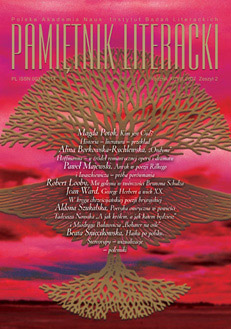„Ondyna” Hoffmanna – u źródeł romantycznej opery i dramatu
E. T. A. Hoffmann’s “Undine”: at Source of Romantic Opera and Dramma
Author(s): Alina Borkowska-RychlewskaSubject(s): Literary Texts
Published by: Instytut Badań Literackich Polskiej Akademii Nauk
Keywords: E. T. A. Hoffmann; Undine; romantic opera; romantic drama
Summary/Abstract: Hoffmann’s "Undine" (1816) constitutes an archetype of European romantic drama, and is viewed by the appearance of the elements ty pical of early romanticism: fantasy, miracle and magic of nature. In this context, the opera’s relationships with early romantic fable and German ballad prove important. The presentation of the real world and the fantasy world in Undine shows how the convention to which dramatic-musical theatre of the turn of 18th and 19th century was subjected reveal a close connection to a convention of romantic fable. Furthermore, mythologisation of the natural forces makes it possible to regard Undine as a heir of so-called Goethe’s "Naturmagische Ballade". "Undine" can be interestingly situated within the theory of romantic drama development, and especially within A. W. Schlegel’s theses. Connections to the fable and the ballad, fantasy and miracle, coexistence of dramatic, lyric, and epic elements in one work and music element – all this allows for a formulation of a statement that the theoreticians’ dream of a “new” theatre came true in Hoffmann’s opera. Moreover, undine’s popularity on European stages reflected not only on the opera, but also within the framework of other theatre genres: magical dramas, feeries, and ballets.
Journal: Pamiętnik Literacki. Czasopismo kwartalne poświęcone historii i krytyce literatury polskiej
- Issue Year: 2007
- Issue No: 2
- Page Range: 27-41
- Page Count: 15
- Language: Polish

